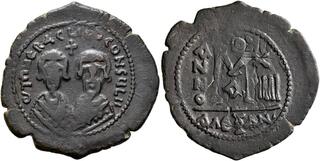| Leu Numismatik AG > Web Auction 28 | Auction date: 9 December 2023 |
| Lot number: 4958 Price realized: 420 CHF (Approx. 477 USD / 443 EUR) Note: Prices do not include buyer's fees. | Show similar lots on CoinArchives Find similar lots in upcoming auctions on |
| Lot description: Revolt of the Heraclii, 608-610. Follis (Bronze, 35 mm, 10.59 g, 12 h), Alexandretta or Alexandria, IY 13 = AD 609. δm N ЄRACLIO CONSULII Bare-headed and bearded bust of Heraclius, wearing consular robes and on the left, and bare-headed and bearded bust of the Exarch Heraclius, wearing consular robes, on the right; between their heads, cross. Rev. Large M between A/N/N/O and X/IIII; above, cross; below, A; in exergue, AΛЄΞANΔ. DOC 15. MIB 16a (Alexandria). SB 722. Rare. Struck from worn dies and with traces of overstriking, otherwise, about very fine. From a European collection, formed before 2005. Heraclius the Elder was a successful Byzantine general of Armenian descent who made a career in the later years of the Roman-Persian War of 572-591. In 595, the emperor Maurice Tiberius appointed Heraclius to magister militum per Armeniam and ordered him to crush the revolt of Samuel Vahewuni and Atat Khorkhoruni, the details of which are reported by the 7th century Armenian bishop and historian Sebeos, who thus sheds a brief light on the general's earlier career due to its connections to Armenian history. We only hear of Heraclius again in 608, when he was serving as the Exarch of Africa and, together with his son and future emperor Heraclius the Younger, decided to put the might of the Exarchate in the balance in an attempt to remove the emperor Phocas from power. We are being told that the main motive behind the Revolt of the Heraclii was their loyalty to the previous emperor Maurice Tiberius, who had been overthrown and killed by Phocas in 602, but the disastrous failures of the usurper's reign and the own personal ambitions of the Heraclii no doubt played a great role in the decision-making. In a very unusual step, the Heraclii initially abstained from declaring themselves emperors but assumed a joint consulship instead. The present issue was struck by the Heraclean forces somewhere in the East (in Alexandria or on Cyprus?), where the general Niketas led a successful offensive against Egypt in 608-610. Its obverse shows us the two Heraclii uncrowned and in consular robes, presenting them as Roman traditionalists defending a just cause against the illegitimate usurper Phocas. It was only when Heraclius the Younger, sailing from Carthage, captured Constantinople in the fall of 610 that he was crowned emperor, the news of which reached his father in Carthage later that year, just shortly before he died. Starting price: 75 CHF |  |



